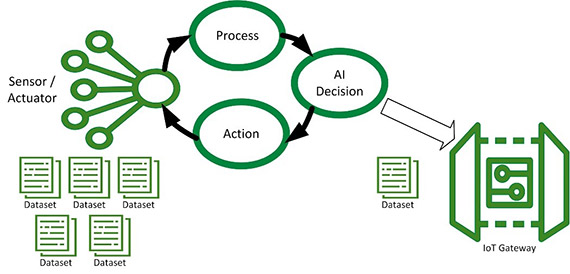
What Is Edge AI?
Edge AI is the deployment of AI models directly on devices at the network’s edge; it reduces dependency on cloud computing by employing on-device processing for low-latency responses. The addition of edge AI to an IoT system – the combination forming an AIoT (Artificial Intelligence of Things) system – can also minimize data overload by analyzing sensor data, recognizing patterns, drawing inferences, and making decisions at the local level; only the relevant results need then be transmitted over the gateway. By minimizing data transfer to and from the cloud, it optimizes bandwidth usage and adapts to resource-constrained edge devices, including microcontrollers and FPGAs.

Edge AI Power Supply Challenges
Edge AI devices are incorporating increasingly powerful processors to handle complex computations locally. Power supply designs are evolving to support these enhanced processing capabilities, providing stable and sufficient power to drive the performance of advanced edge AI hardware.
The following are examples of challenges and requirements posed by edge AI systems for power supply systems:
Power Efficiency: Edge AI devices demand power supplies that prioritize efficiency and low power consumption. Designers are focusing on creating power-efficient solutions to maximize the longevity of battery-powered edge devices and minimize the energy footprint of connected systems.
Compact Form Factors and Thermal Efficiency: In many edge computing environments, inherent space constraints require power supplies with compact form factors and outstanding thermal efficiency. Power systems include smaller, lightweight power supplies that effectively manage heat, meeting the thermal challenges of edge devices operating in diverse environments. Designs must be compatible with edge form factors, addressing the diverse range of devices and systems deployed at the edge of the network.
Scalability for Edge Clusters: Edge AI often involves the deployment of clusters or networks of interconnected devices. Power supply designs are evolving to support the scalability requirements of edge clusters, providing modular solutions that can efficiently scale to meet the power demands of expanding edge computing infrastructures.
Intelligent Power Management: Due to dynamic workloads with varying power requirements, edge devices often require adaptive power management. Intelligent power management features are becoming integral to power supply designs, allowing for dynamic allocation of power based on the real-time needs of different components. This adaptability optimizes energy consumption in edge AI systems.
Edge-Focused Redundancy: Reliability is paramount for edge AI systems, particularly in remote or mission-critical scenarios. Power supply designs are adding edge-focused redundancy features, ensuring continuous operation even in the event of a power supply failure. These redundant designs are essential for maintaining reliability and minimizing downtime in edge deployments.
Integration with Edge Analytics: Power supplies for Edge AI are incorporating integration with edge analytics and monitoring capabilities. This integration enables real-time insights into power consumption, efficiency, and system health, facilitating proactive maintenance and optimizing power supply performance based on the unique usage patterns of edge devices.
Edge AI Customization and Adaptability: Edge AI applications vary widely, and power supply designs are becoming more customizable and adaptable to the specific requirements of different edge use cases. This flexibility allows for tailoring power solutions to the unique demands of diverse edge AI deployments.
The Benefits of a Power Supply Digital Communication Bus for Edge AI Design
Incorporating a digital communications interface in a power supply seamlessly integrates it into an edge AI design. Combined with machine learning algorithms, the power supply now becomes an active part of the entire system: contributing data on power usage; facilitating power management; and enabling redundant operation.
The Power Management (PM) bus protocol proves highly beneficial for AIoT applications: not only can the digital power supply be remotely switched on or off or placed into standby to conserve power, but the PM command set also allows the remote adjustment of the output voltage remote setting of current and power limits, plus monitoring of the AC input line and the power supply temperature. Additionally, the power supply internal memory can be interrogated for present and previous error codes.
Fig. 2: RECOM’s RACM1200-V offers digital communication for simple integration into an edge AI design (Source: RECOM)
RECOM offers a family of power supplies with PM-Bus interfaces for seamless integration into AIoT systems. The RACM1200-V family offers up to 1200V (1000W without fan) power; 24V or 48V outputs; and high efficiency exceeding 90% from 15% load. Models equipped with the PMB option offer PM-bus communication up to 100kHz accompanied by a comprehensive set of commands that include on/off control, voltage and current measuring, status indication, fault reporting, and more.
Partner with RECOM for Edge AI Power Supply
The emergence of Edge AI is reshaping power supply design, emphasizing efficiency, scalability, and adaptability. As Edge AI applications become more prevalent, power supplies play a crucial role in ensuring the reliable and optimal operation of devices at the edge of the network. Designers are actively addressing the unique challenges posed by Edge AI to deliver power solutions that align with the demands of this dynamic and rapidly evolving field. RECOM’s RACM1200-V power supplies include a PM-bus interface that eases integration into edge AI designs. Contact us today to partner on your next project.


















